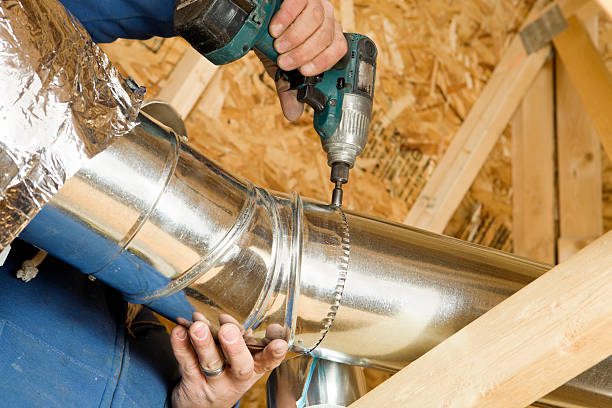When it comes to your HVAC system, the choice of duct material plays a crucial role in its performance and longevity. Each duct material has its own set of advantages and disadvantages, and making the right choice is essential for ensuring your system operates efficiently. In this blog, we’ll explore the pros and cons of various duct materials to help you make an informed decision for your specific needs.
From lightweight and flexible aluminum ducts to excellent thermal insulators like fiberglass and the durability of stainless steel and copper, we’ll dive into the characteristics that make each material unique. We’ll also discuss factors such as cost, ease of installation, resistance to corrosion, and suitability for different temperature ranges. Whether you’re embarking on a new HVAC installation or considering duct replacement, understanding the pros and cons of different duct materials is crucial. Join us as we navigate the world of ductwork to help you make the right choice for your home or commercial space.
Aluminum ducts: Lightweight and flexible, but may not be as durable as other options
Aluminum ducts are a popular choice in many HVAC systems due to their lightweight and flexible nature. These ducts offer ease of installation in various spaces, making them suitable for both residential and commercial applications. The lightweight design allows for easier handling and maneuverability during the installation process. Another advantage of aluminum ducts is their flexibility, which allows them to bend and adapt to different angles and configurations. This flexibility makes it easier to fit the ducts into tight spaces or around obstacles, providing more flexibility in the overall design of the system.
However, it’s important to note that aluminum ducts may not be as durable as other options available in the market. While they can withstand normal wear and tear, they are more susceptible to damage from impact or extreme temperatures compared to other materials like stainless steel or galvanized steel. This sensitivity can lead to the need for more frequent repairs or replacements over time. In conclusion, aluminum ducts offer the benefits of being lightweight and flexible, making them a popular choice for HVAC systems, though their durability is where they fall short. When considering which duct material to use, it’s important to carefully evaluate the specific needs of the project to ensure the best choice in terms of performance, durability, and cost-effectiveness.
Fiberglass ducts: Excellent for thermal insulation but can be expensive and may require professional installation
Fiberglass ducts are widely recognized for their excellent thermal insulation properties. They are designed to prevent heat loss or gain, ensuring that the desired temperature is maintained within a space. This temperature control makes them particularly suitable for areas where energy efficiency is a priority, such as residential houses or commercial buildings. Additionally, the insulation provided by fiberglass ducts helps to reduce noise transmission, contributing to a more comfortable and peaceful environment.
With all that said, it is worth considering the potential drawbacks of fiberglass ducts. One of the key concerns is their cost. Compared to other duct materials, fiberglass ducts can be more expensive, especially if the installation requires professional expertise. This cost factor should be taken into account when budgeting for HVAC system installation or renovation projects. Moreover, the installation process for fiberglass ducts can be intricate, requiring the skills and knowledge of trained professionals. While DIY installation is possible, it is important to ensure proper sealing and fitting to maximize the effectiveness of the ducts.
In summary, fiberglass ducts offer exceptional thermal insulation capabilities, making them an attractive option for those seeking energy efficiency and comfort. However, the potential expenses and the need for professional installation should be carefully considered to make an informed decision. By weighing these tradeoffs, one can select the most appropriate duct material for their specific needs and budget constraints.
Stainless steel ducts: Highly durable and resistant to corrosion, but can be costly and heavy
Stainless steel ducts are known for their exceptional durability and resistance to corrosion. Made from high-quality stainless steel, these ducts can withstand harsh environmental conditions, ensuring a long lifespan and consistent performance. With their robust construction, these ducts require minimal maintenance, saving both time and money in the long run. Remember that stainless steel ducts can come with a higher price tag compared to other options. The cost of the materials, as well as the expertise required for installation, may contribute to the overall expense.
Additionally, stainless steel ducts tend to be heavier than alternative choices, which can pose challenges during installation and transportation. Despite the potential drawbacks, the durability and corrosion resistance of stainless steel ducts makes them an excellent choice for applications where longevity is a priority. Industries such as manufacturing, chemical processing, and wastewater treatment can greatly benefit from the reliability and strength of stainless steel ducts. When considering the tradeoffs between cost and durability, stainless steel remains a top contender in providing reliable and long-lasting ducting solutions.
PVC ducts: Affordable and easy to install, but may not be suitable for high-temperature applications
PVC ducts, also known as polyvinyl chloride ducts, are a popular choice for many homeowners and contractors due to their affordability and ease of installation. PVC ducts are lightweight and flexible, making them convenient for various applications. They are commonly used in residential and small commercial buildings for ventilation and air conditioning systems. One of the main considerations when choosing PVC ducts is their suitability for high-temperature applications. PVC is not recommended for use in environments where temperatures exceed a certain threshold, typically around 140°F (60°C). High temperatures can cause PVC ducts to soften, warp, or even release harmful gases.
Therefore, it is important to assess the temperature requirements of your project and ensure that PVC ducts are a suitable choice. While PVC ducts may not be suitable for high-temperature applications, they offer several advantages in other scenarios. Their affordability is particularly attractive, especially for budget-conscious individuals. PVC ducts are also relatively easy to install, making them a convenient option for DIY projects or quick installations. However, it is crucial to consider the temperature limitations and potential trade-offs before opting for PVC ducts in order to ensure optimum performance and safety.
Galvanized steel ducts: Strong and long-lasting but prone to rust and may require regular maintenance
Galvanized steel ducts are a popular choice for many HVAC systems due to their strength and durability. These ducts are known to be long-lasting, providing a reliable and sturdy option for delivering air throughout a building. The galvanization process involves coating the steel with a protective layer of zinc, which helps to prevent corrosion and increase the ducts’ resistance to rust.
Like all other ducts, however, galvanized steel is not immune to having drawbacks. It’s particularly important to note that galvanized steel ducts are not immune to rust and corrosion. Over time, the protective zinc coating can wear off or become damaged, leaving the steel exposed to moisture and other elements that may cause it to rust.
Regular maintenance is therefore necessary to ensure the longevity of galvanized steel ducts. Maintenance tasks may involve inspecting the ducts for any signs of rust, repairing any damages, and applying a fresh coat of protective coating as needed. By staying on top of maintenance, the potential issues with rust can be mitigated, allowing the ducts to continue serving their purpose effectively.
Flexible ducts: Versatile and easy to install, but may not be as efficient for airflow compared to rigid options
Flexible ducts are a popular choice for many homeowners due to their versatility and ease of installation. These ducts are made from a variety of materials, including plastic and foil, which allows them to bend and flex around corners and obstacles. This flexibility makes them a practical choice for situations where rigid ducts would be challenging to install.
However, it’s important to note that flexible ducts may not be as efficient for airflow compared to rigid options. The flexible nature of these ducts can cause restrictions in the airflow, leading to decreased efficiency. This restrictiveness can reduce airflow to certain areas of the home, which may affect overall comfort and temperature control.
Therefore, it’s crucial to consider the specific needs of your HVAC system and the layout of your home before deciding on flexible ducts. Despite this potential drawback, flexible ducts offer their own set of advantages. They are often more affordable than rigid ducts and can be easily customized to fit the required length. Their flexibility also makes it easier to maneuver around obstacles and tight spaces, simplifying the installation process.
Additionally, flexible ducts can help reduce noise transmission, improving the overall comfort of your living environment. In conclusion, flexible ducts provide homeowners with a convenient and versatile option for their HVAC system. While they may not be as efficient for airflow compared to rigid ducts, the tradeoffs in affordability, ease of installation, and noise reduction make them a practical choice for many. Consider your specific requirements and consult with a professional to determine the most suitable type of ductwork for your home.
Polyurethane ducts: Excellent for soundproofing and insulation but may not be as common or readily available
Polyurethane ducts are an excellent choice for those looking to enhance soundproofing and insulation in their space. The unique properties of polyurethane materials allow these ducts to effectively block out noise and maintain internal temperature for optimal comfort. Whether you’re working from a home office, trying to create a quiet environment for sleep, or looking to reduce noise pollution in a commercial setting, polyurethane ducts can make a noticeable difference. With their ability to provide exceptional soundproofing and insulation, these ducts offer an ideal solution for noise reduction.
However, polyurethane ducts may not be as readily available as some other options, and they may be less common in the market. As a result, there is limited availability of different sizes and configurations, making it important to carefully consider your specific requirements. Additionally, the niche nature of polyurethane ducts may result in slightly higher costs compared to more widely used duct materials. The limited accessibility and potentially higher price points can pose challenges for those seeking to install polyurethane ducts. That’s why it’s essential to weigh the benefits of superior insulation and soundproofing against the potential tradeoffs of availability and cost when considering this option.
Copper ducts: Highly durable and resistant to corrosion, but can be expensive and may require professional installation.
Copper ducts are a popular choice for many homeowners due to their high durability and resistance to corrosion. These ducts are built to last, ensuring that they can withstand the wear and tear of daily use without deteriorating. Copper is also highly resistant to corrosion, making it an excellent option for HVAC systems in humid environments or areas with high levels of moisture.
As far as drawbacks are concerned, the main one associated with copper ducts is cost. Compared to other materials, copper ducts are typically more expensive to purchase and install. The higher price tag may deter some homeowners from choosing this option, especially if their budget is a significant factor. Additionally, because copper ducts require specialized knowledge and skills for proper installation, professional installation may be necessary, adding another layer of expense. In other words, while copper ducts offer exceptional durability and corrosion resistance, they come at a higher cost and may require professional installation.

A repairman wearing a yellow helmet and checking the air conditioner
Are copper ducts a good option for ductwork?
Absolutely! Copper ducts are highly durable and resistant to corrosion, making them a great choice for long-lasting ductwork. Just make sure you have the budget to purchase and install them.
Are copper ducts expensive?
Yes, copper ducts can be more expensive compared to other options. However, their durability and resistance to corrosion make them worth the investment.
Do copper ducts require professional installation?
It is highly recommended to have copper ducts professionally installed to ensure proper fitting and sealing, maximizing the efficiency of your HVAC system.
Are aluminum ducts a good alternative to copper ducts?
Aluminum ducts are lightweight and flexible, making them a popular choice. However, they may not be as durable as other options.
What are the advantages of fiberglass ducts?
Fiberglass ducts are excellent for thermal insulation, helping to maintain desired temperatures. However, they can be expensive and usually require professional installation.
Are stainless steel ducts a good option for ductwork?
Yes, stainless steel ducts are highly durable and resistant to corrosion, making them a reliable choice. However, they can be costly and heavier compared to other materials.
Can PVC ducts be used in high-temperature applications?
PVC ducts are affordable and easy to install, but they may not be suitable for high-temperature applications due to their lower heat resistance.
Are galvanized steel ducts a good choice for ductwork?
Galvanized steel ducts are strong and long-lasting, making them a reliable option. However, they are prone to rust and require regular maintenance to prevent corrosion.
Are flexible ducts efficient for airflow?
Flexible ducts are versatile and easy to install, but they may not be as efficient for airflow compared to rigid options. Proper installation and sealing are important to minimize air leaks.
What are the advantages of polyurethane ducts?
Polyurethane ducts are excellent for soundproofing and insulation, helping to reduce noise and maintain desired temperatures. However, they may not be as common or readily available as other materials.
Receive a No-Cost Estimate from Fresh Air Duct Cleaning in Dallas-Fort Worth
Understanding the cost factors involved in duct installation services can be complex, but we’re here to make it easier for you. After exploring our blog, you should have a clearer idea of what to expect. However, the most straightforward approach is to request a free estimate from your HVAC provider. If you’re in the Dallas-Fort Worth area, look no further than Fresh Air Duct Cleaning. Contact us today, and we’ll promptly offer you a complimentary estimate tailored to your home’s needs.

